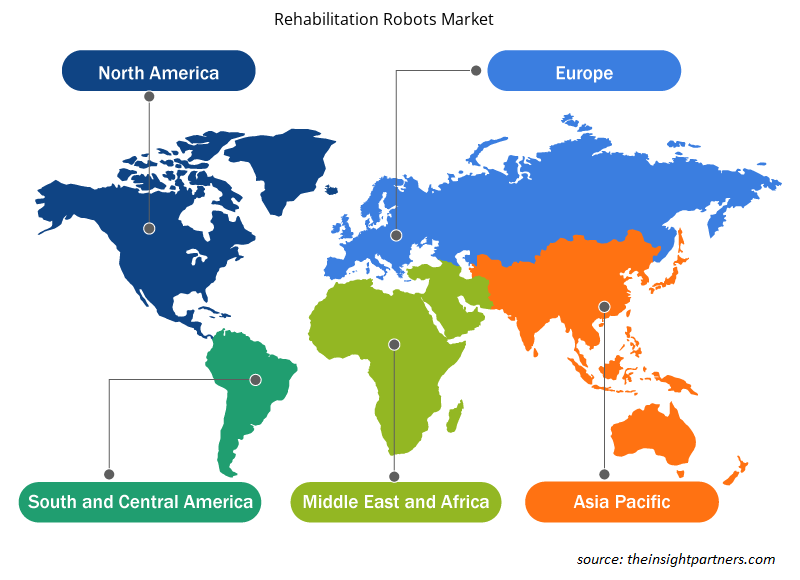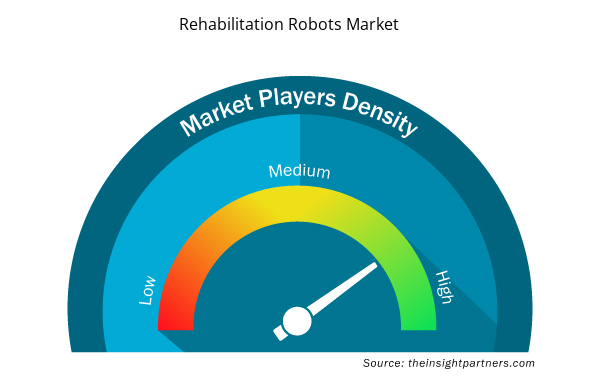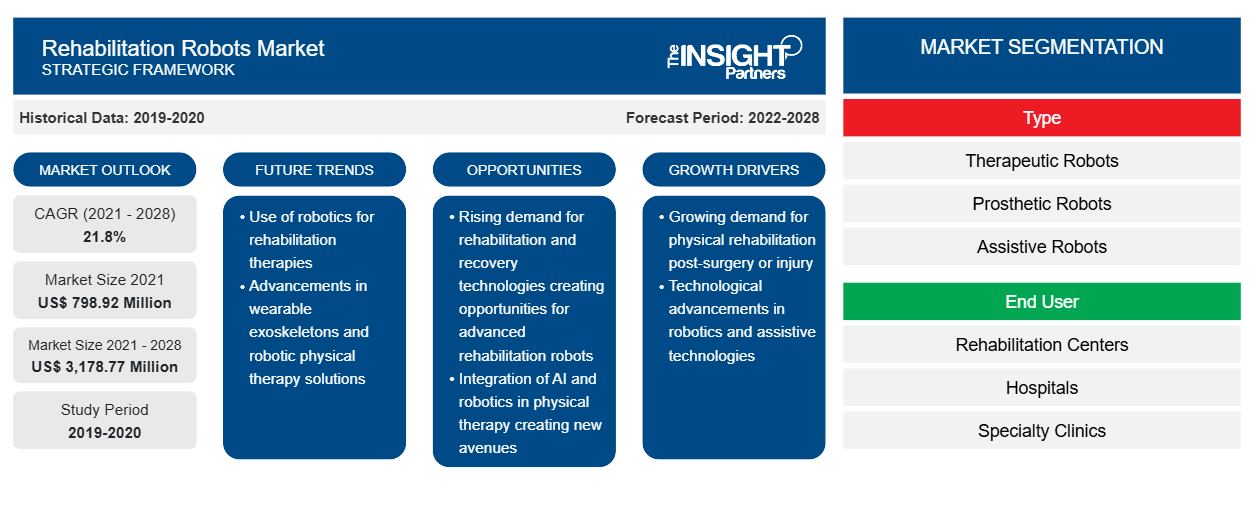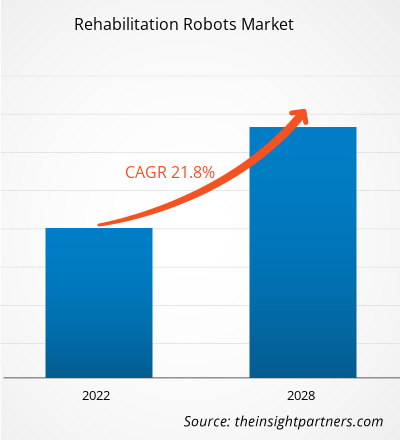Il mercato dei robot riabilitativi è stato valutato 798,92 milioni di dollari nel 2021 e si prevede che raggiungerà i 3.178,77 milioni di dollari entro il 2028; si prevede una crescita a un CAGR del 21,8% dal 2021 al 2028.
I robot riabilitativi sono utilizzati nel processo di recupero dei pazienti disabili in posizione eretta, equilibrio e andatura. Questi robot devono tenere il passo con gli esseri umani e i loro movimenti; pertanto, durante la produzione della macchina, i produttori devono garantire che sia coerente con i progressi del paziente. Si prevede che il mercato dei robot riabilitativi assisterà a una crescita significativa nei prossimi anni a causa di fattori quali l'aumento della popolazione geriatrica, l'ictus e la formazione assistita da robot nella terapia riabilitativa. Tuttavia, l'elevato costo dei dispositivi ostacola la crescita del mercato.
Approfondimenti di mercato
Personalizza questo report in base alle tue esigenze
Riceverai la personalizzazione gratuita di qualsiasi report, comprese parti di questo report, o analisi a livello nazionale, pacchetto dati Excel, oltre a usufruire di grandi offerte e sconti per start-up e università
- Scopri le principali tendenze di mercato in questo rapporto.Questo campione GRATUITO includerà analisi di dati che spaziano dalle tendenze di mercato alle stime e alle previsioni.
Aumento della popolazione geriatrica, ictus e formazione assistita da robot nella terapia riabilitativa
Con la crescita della ricerca correlata alla robotica riabilitativa, la produzione e l'impiego di robot terapeutici riabilitativi stanno aumentando in tutto il mondo. Giappone e Cina sono tra i paesi dell'Asia-Pacifico con un'elevata popolazione anziana; questi paesi, così come altre nazioni in via di sviluppo nella regione, stanno assistendo ai progressi nella tecnologia medica. Secondo il Ministero degli Affari Interni e delle Comunicazioni, circa 35,2 milioni di persone in Giappone avevano 65 anni o più nel 2017 e si prevede che questa cifra salirà a 36,2 milioni entro il 2020. Pertanto, le principali aziende del settore sanitario sono disposte a investire nello sviluppo di tecnologie avanzate per fornire assistenza ai residenti più anziani della regione. Pertanto, l'aumento della popolazione anziana e la crescente prevalenza di ictus, che rende le persone immobili, sono tra i fattori significativi che guidano la domanda di robot riabilitativi.
La terapia riabilitativa robotica viene utilizzata per fornire un allenamento ad alta intensità per pazienti affetti da disturbi motori causati da malattie del midollo spinale o ictus. L'ictus è una delle principali cause di grave disabilità a lungo termine negli Stati Uniti, secondo i Centers for Disease Control and Prevention (CDC). Stanchezza, emiparesi e difficoltà a camminare sono alcuni effetti di un ictus. Inoltre, i robot riabilitativi forniscono un allenamento personalizzato, orientato alle attività, prolungato, intensivo, standardizzato e riproducibile ai pazienti colpiti da ictus o altre lesioni cerebrali non progressive. Pertanto, la crescente domanda di servizi sanitari migliori e più rapidi guida la crescita del mercato complessivo dei robot riabilitativi.
Tipo Informazioni
In base al tipo, il mercato dei robot riabilitativi è segmentato in robot terapeutici, robot assistivi, robot esoscheletrici e robot protesici. Il segmento dei robot esoscheletrici ha detenuto la quota maggiore del mercato nel 2021 e si prevede che registrerà il CAGR più elevato durante il periodo di previsione.
Utente finale
In base all'utente finale, il mercato dei robot riabilitativi è segmentato in ospedali, centri riabilitativi e cliniche specialistiche. Il segmento dei centri riabilitativi ha detenuto la quota maggiore del mercato nel 2021 e si stima che registrerà il CAGR più elevato durante il periodo di previsione.
Gli operatori che operano nel mercato dei robot riabilitativi hanno adottato in larga misura la strategia di innovazione di prodotto per soddisfare la mutevole domanda dei clienti in tutto il mondo, il che consente loro anche di mantenere il proprio marchio a livello globale.
Approfondimenti regionali sul mercato dei robot riabilitativi
Le tendenze regionali e i fattori che influenzano il mercato dei robot riabilitativi durante il periodo di previsione sono stati ampiamente spiegati dagli analisti di Insight Partners. Questa sezione discute anche i segmenti e la geografia del mercato dei robot riabilitativi in Nord America, Europa, Asia Pacifico, Medio Oriente e Africa e America meridionale e centrale.

- Ottieni i dati specifici regionali per il mercato dei robot riabilitativi
Ambito del rapporto di mercato sui robot riabilitativi
| Attributo del report | Dettagli |
|---|---|
| Dimensioni del mercato nel 2021 | 798,92 milioni di dollari USA |
| Dimensioni del mercato entro il 2028 | 3.178,77 milioni di dollari USA |
| CAGR globale (2021 - 2028) | 21,8% |
| Dati storici | 2019-2020 |
| Periodo di previsione | 2022-2028 |
| Segmenti coperti | Per tipo
|
| Regioni e Paesi coperti | America del Nord
|
| Leader di mercato e profili aziendali chiave |
|
Densità dei player del mercato dei robot riabilitativi: comprendere il suo impatto sulle dinamiche aziendali
Il mercato dei robot riabilitativi sta crescendo rapidamente, spinto dalla crescente domanda degli utenti finali dovuta a fattori quali l'evoluzione delle preferenze dei consumatori, i progressi tecnologici e una maggiore consapevolezza dei vantaggi del prodotto. Con l'aumento della domanda, le aziende stanno ampliando le loro offerte, innovando per soddisfare le esigenze dei consumatori e capitalizzando sulle tendenze emergenti, il che alimenta ulteriormente la crescita del mercato.
La densità degli operatori di mercato si riferisce alla distribuzione di aziende o società che operano in un particolare mercato o settore. Indica quanti concorrenti (operatori di mercato) sono presenti in un dato spazio di mercato in relazione alle sue dimensioni o al valore di mercato totale.
Le principali aziende che operano nel mercato dei robot riabilitativi sono:
- Società di laboratori Bionik
- Società anonima Cyberdyne Inc.
- Esatto
- Società per azioni Bionics Holdings Inc.
- Rewalk Robotica Ltd
Disclaimer : le aziende elencate sopra non sono classificate secondo un ordine particolare.

- Ottieni una panoramica dei principali attori del mercato dei robot riabilitativi
Per tipo
- Robot esoscheletrici
- Robot terapeutici
- Robot Assistivi
- Robot protesici
Utente finale
- Centri di riabilitazione
- Ospedali
- Cliniche specialistiche
Per Geografia
- America del Nord
- NOI
- Canada
- Messico
- Europa
- Regno Unito
- Germania
- Francia
- Italia
- Spagna
- Resto d'Europa
- Asia Pacifico
- Cina
- Giappone
- India
- Australia
- Corea del Sud
- Resto dell'Asia Pacifica
- Medio Oriente e Africa
- Emirati Arabi Uniti
- Arabia Saudita
- Sudafrica
- Resto del Medio Oriente e Africa
- America del Sud e Centro
- Brasile
- Argentina
- Resto del Sud e Centro America
Profili aziendali
- Società di laboratori Bionik
- Società anonima Cyberdyne Inc.
- Società per azioni Ekso Bionics Holdings Inc.
- Rewalk Robotica Ltd
- Azienda agricola Hocoma
- Società di riabilitazione-robotica a responsabilità limitata
- Kinova Inc
- Rex Bionics Ltd
- La Toyota Motor Corporation
- Myomo Inc
- Analisi storica (2 anni), anno base, previsione (7 anni) con CAGR
- Analisi PEST e SWOT
- Valore/volume delle dimensioni del mercato - Globale, regionale, nazionale
- Industria e panorama competitivo
- Set di dati Excel


- Analog-to-Digital Converter Market
- Aerosol Paints Market
- Point of Care Diagnostics Market
- Arterial Blood Gas Kits Market
- Lymphedema Treatment Market
- Skin Tightening Market
- Biopharmaceutical Contract Manufacturing Market
- Explosion-Proof Equipment Market
- Skin Graft Market
- Portable Power Station Market

Report Coverage
Revenue forecast, Company Analysis, Industry landscape, Growth factors, and Trends

Segment Covered
This text is related
to segments covered.

Regional Scope
North America, Europe, Asia Pacific, Middle East & Africa, South & Central America

Country Scope
This text is related
to country scope.
Domande frequenti
Bionik Laboratories Corporation, Cyberdyne Inc., Ekso Bionics Holdings Inc, Rewalk Robotics Ltd, Hocoma Ag, Rehab-robotics Company Limited, Kinova Inc, Rex Bionics Ltd, Toyota Motor Corporation, Myomo Inc among Others. are some of the major players in the Rehabilitation Robots market.
Rehabilitation robots assist handicapped people in regaining their ability to stand, balance, and walk. Because these robots must keep up with a human's movement, the machine's designers must ensure that the machine will be consistent with the patient's development.
The growth of the market is attributed to the Factors driving the market growth include the rise in geriatric population, stroke and robot-assisted training in rehabilitation therapy. However, high cost of the devices to hinder the market growth.
Trends and growth analysis reports related to Life Sciences : READ MORE..
The List of Companies - Rehabilitation Robots Market
- Bionik Laboratories Corporation
- Cyberdyne Inc.
- Ekso
- Bionics Holdings Inc
- Rewalk Robotics Ltd
- Hocoma Ag
- Rehab-robotics Company Limited
- Kinova Inc, Rex Bionics Ltd
- Toyota Motor Corporation
- Myomo Inc.
The Insight Partners performs research in 4 major stages: Data Collection & Secondary Research, Primary Research, Data Analysis and Data Triangulation & Final Review.
- Data Collection and Secondary Research:
As a market research and consulting firm operating from a decade, we have published and advised several client across the globe. First step for any study will start with an assessment of currently available data and insights from existing reports. Further, historical and current market information is collected from Investor Presentations, Annual Reports, SEC Filings, etc., and other information related to company’s performance and market positioning are gathered from Paid Databases (Factiva, Hoovers, and Reuters) and various other publications available in public domain.
Several associations trade associates, technical forums, institutes, societies and organization are accessed to gain technical as well as market related insights through their publications such as research papers, blogs and press releases related to the studies are referred to get cues about the market. Further, white papers, journals, magazines, and other news articles published in last 3 years are scrutinized and analyzed to understand the current market trends.
- Primary Research:
The primarily interview analysis comprise of data obtained from industry participants interview and answers to survey questions gathered by in-house primary team.
For primary research, interviews are conducted with industry experts/CEOs/Marketing Managers/VPs/Subject Matter Experts from both demand and supply side to get a 360-degree view of the market. The primary team conducts several interviews based on the complexity of the markets to understand the various market trends and dynamics which makes research more credible and precise.
A typical research interview fulfils the following functions:
- Provides first-hand information on the market size, market trends, growth trends, competitive landscape, and outlook
- Validates and strengthens in-house secondary research findings
- Develops the analysis team’s expertise and market understanding
Primary research involves email interactions and telephone interviews for each market, category, segment, and sub-segment across geographies. The participants who typically take part in such a process include, but are not limited to:
- Industry participants: VPs, business development managers, market intelligence managers and national sales managers
- Outside experts: Valuation experts, research analysts and key opinion leaders specializing in the electronics and semiconductor industry.
Below is the breakup of our primary respondents by company, designation, and region:

Once we receive the confirmation from primary research sources or primary respondents, we finalize the base year market estimation and forecast the data as per the macroeconomic and microeconomic factors assessed during data collection.
- Data Analysis:
Once data is validated through both secondary as well as primary respondents, we finalize the market estimations by hypothesis formulation and factor analysis at regional and country level.
- Macro-Economic Factor Analysis:
We analyse macroeconomic indicators such the gross domestic product (GDP), increase in the demand for goods and services across industries, technological advancement, regional economic growth, governmental policies, the influence of COVID-19, PEST analysis, and other aspects. This analysis aids in setting benchmarks for various nations/regions and approximating market splits. Additionally, the general trend of the aforementioned components aid in determining the market's development possibilities.
- Country Level Data:
Various factors that are especially aligned to the country are taken into account to determine the market size for a certain area and country, including the presence of vendors, such as headquarters and offices, the country's GDP, demand patterns, and industry growth. To comprehend the market dynamics for the nation, a number of growth variables, inhibitors, application areas, and current market trends are researched. The aforementioned elements aid in determining the country's overall market's growth potential.
- Company Profile:
The “Table of Contents” is formulated by listing and analyzing more than 25 - 30 companies operating in the market ecosystem across geographies. However, we profile only 10 companies as a standard practice in our syndicate reports. These 10 companies comprise leading, emerging, and regional players. Nonetheless, our analysis is not restricted to the 10 listed companies, we also analyze other companies present in the market to develop a holistic view and understand the prevailing trends. The “Company Profiles” section in the report covers key facts, business description, products & services, financial information, SWOT analysis, and key developments. The financial information presented is extracted from the annual reports and official documents of the publicly listed companies. Upon collecting the information for the sections of respective companies, we verify them via various primary sources and then compile the data in respective company profiles. The company level information helps us in deriving the base number as well as in forecasting the market size.
- Developing Base Number:
Aggregation of sales statistics (2020-2022) and macro-economic factor, and other secondary and primary research insights are utilized to arrive at base number and related market shares for 2022. The data gaps are identified in this step and relevant market data is analyzed, collected from paid primary interviews or databases. On finalizing the base year market size, forecasts are developed on the basis of macro-economic, industry and market growth factors and company level analysis.
- Data Triangulation and Final Review:
The market findings and base year market size calculations are validated from supply as well as demand side. Demand side validations are based on macro-economic factor analysis and benchmarks for respective regions and countries. In case of supply side validations, revenues of major companies are estimated (in case not available) based on industry benchmark, approximate number of employees, product portfolio, and primary interviews revenues are gathered. Further revenue from target product/service segment is assessed to avoid overshooting of market statistics. In case of heavy deviations between supply and demand side values, all thes steps are repeated to achieve synchronization.
We follow an iterative model, wherein we share our research findings with Subject Matter Experts (SME’s) and Key Opinion Leaders (KOLs) until consensus view of the market is not formulated – this model negates any drastic deviation in the opinions of experts. Only validated and universally acceptable research findings are quoted in our reports.
We have important check points that we use to validate our research findings – which we call – data triangulation, where we validate the information, we generate from secondary sources with primary interviews and then we re-validate with our internal data bases and Subject matter experts. This comprehensive model enables us to deliver high quality, reliable data in shortest possible time.


 Ottieni un campione gratuito per questo repot
Ottieni un campione gratuito per questo repot